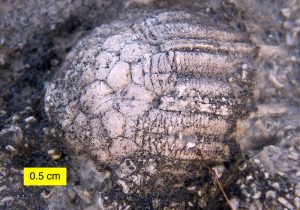The Phylum Echinodermata is upon us. These organisms could be from Mars if we didn’t know better. You will first want to visit the fantastic echinoderm page of the Tree of Life Project. (Friend of the department Bill Ausich of OSU is a member of the Tree of Life echinoderm team.) I find the images on the Animal Diversity Web for echinoderms page (University of Michigan) to be useful. There are numerous websites for specific echinoderm groups. The best I’ve found include ophiuroids, echinoids, the crown-of-thorns starfish, and the Wikipedia page on crinoids. Also check out this nice page on the Carboniferous Crawfordsville crinoids — some of the best in the world. This echinoderm webpage by Teresa Zubi is a lot of fun. (Well, OK, some fun.) This clip of a “sea pig” (Scotoplanes — a holothurian) in deposit-feeding action is a classic. And you won’t see echinoderms the same ever again after watching this time-lapse video from Antarctica. Creepy, but they get their own from the Icicle of Death. And why are all these sea urchins going to the same place with such grim determination? Jonathan Bird’s Blue World has a video on sea stars that is entertaining. Here’s a nice Japanese clip on sand dollar moving and feeding, and here’s a hauntingly beautiful Brazilian production on the reproduction and development of a sea biscuit.
On Tuesday, November 20, by 8:00 a.m., your field trip reports are due on paper to me. I’m sure you haven’t forgotten.
Your final two quizzes (#11 and #12) will be “superquizzes” with lots of extra credit. Quiz #11 will be fill-in-the-blank questions from the first half of the course (through bryozoans); quiz #12 from the second.

Eucalyptocrinites calyx; Kaugatuma Formation (Upper Silurian, Pridoli), Saaremaa, Estonia. Specimen found by Nick Fedorchuk.
Geology in the News –
There is an interesting argument that the Late Cretaceous asteroid hit just the right spot to cause the global extinctions. The hypothesis is that striking an area rich in petroleum injected massive amounts of soot into the atmosphere that further cooled climate. There will be debates soon over this.
Here is an excellent BBC article on saving coral. Are we willing to make the change to ensure the survival of coral reefs and thus oceanic ecosystems? So far the answer is a grim no.
The search for Oort Clouds around other stars has yielded surprising results, with some evidence suggesting they go back to the early days of the Universe.
